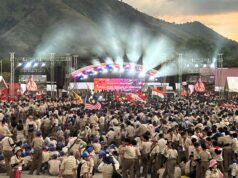ON MONDAY, Feb. 26, in what can be the culmination of the celebration of its Kaganapan 2024, the city government “bestowed upon San Fernando’s ‘Cityhood Heroes’ a day of recognition to honor ‘their significant contributions in the Cityhood journey.’”
“Leading the roster of awardees was former Mayor and Congressman Dr. Jesus Reynaldo “Rey” Aquino, who spent a certain three years of his life as a local chief executive campaigning non-stop in the Congress and the Senate for San Fernando’s cityhood.” So read the post in the social media page of the city information office, naming some significant others who were accorded due recognition.
“Atty. Oscar Rodriguez, who likewise served as San Fernando Mayor and Pampanga Third District Congressman, was also one of the awardees…” the post noted. Thereby, the city government utterly dishonored Rodriguez; relegating him to a mere footnote of the history he himself crafted.
Oscar Samson Rodriguez did not merely serve as city mayor and Pampanga 3rd District congressman but can rightfully claim paternity over the cityhood of San Fernando.
Short in memory – it has been only 23 years since, and long in ignorance is the city government of an epochal instance in the history of San Fernando. It ought to hang its head in shame!
Against the caution of a well-meaning friend who said the collective intelligence at city hall today could be contained on the head of a pin, hence the futility of any discussion, I would still share this definitive narrative on the cityhood saga of San Fernando lifted from my book Oca: A Story of Struggle published in 2005.
Fathering the City
ABORTED BY the threat of lahar after its very conception in 1995, miscarried – induced by the financial crisis – in 1997, and stillborn because of the 1998 elections. That was the wringer the dream of cityhood for Pampanga’s capital town went through.
“But for the persistence and dogged determination of Congressman Oscar S. Rodriguez, there would have been no birthing to the City of San Fernando,” says Redgie Salas-Szal, a member of the legislative staff that prepared the paperwork for cityhood.
Soon as the din of the 1995 elections died down, Oca, fresh from electoral victory, took with characteristic boldness the preparatory steps to the realization of his dream by immediately buckling down to work in preparing the bill at the House of Representatives to start the municipality’s campaign for cityhood.
Disaster came in October that year, with lahar rampages that buried Barrio Cabalantian, Bacolor and hit San Pedro Cutud, Sto. Nino, San Juan and threatened the very center of San Fernando.
The exigency of San Fernando’s very survival took paramouncy, and the preparations for the cityhood bill had to be shelved, albeit temporarily.
Battling, if not belittling the scepticism of national government officials – they that cried to “let nature take its course”” and called for the abandonment of the province – Oca maximized his efforts in saving Pampanga and San Fernando from the onslaught of lahar, mobilizing citizen participation in lobbying government for engineering interventions. The FVR Megadike stands today as a solid testament to these efforts.
Towards the end of 1996, when the province was assured of relative safety from lahar, Oca picked up anew the pursuit of cityhood. Alas, lack of support from the municipal government took the wind out of the cityhood sails.
Priority was still anti-lahar infrastructure and flood-mitigating measures. The all-important requirements for cityhood took the back seat in the municipal government. Eventually, the cityhood bill gathered dust at the House Committee on Local Government where it was referred after its filing.
Then in January 1997, intense pressure from a cross-section of the San Fernando community prodded the Sangguniang Bayan to pass Resolution No. 97-001 – sponsored by Councilors Eduardo Quiambao and Ceferino Laus – requesting the Congress of the Philippine through Rep. Oscar S. Rodriguez to convert the municipality of San Fernando into a component city.
A separate resolution for the Senate was unanimously approved by the SB a month later.
On April 23, 1997, Oca filed HB9267, “An Act Converting the Municipality of San Fernando into a Component City to be known as the City of San Fernando.”
But as the cityhood movement gained renewed momentum, the election season came. And as is the way of things in the Philippines, everything stops to give way to politics. Cityhood was lost in the cacophony of the election campaign.
Still, Oca would not just be denied: of his re-election, and his cityhood dream. He lost no time refiling the cityhood bill as HB1397, this time ensuring that the municipal government met all the prerequisites for cityhood, starting with the town’s barangay councils passing resolutions “strongly” endorsing the transformation of San Fernando into a city.
In a letter on July 6, 1998, Mayor Rey Aquino urged the SB to pass a resolution endorsing the conversion of the municipality into a city. Two short days after, Resolution No. 98-001, sponsored by Councilor Dennis Dizon, was unanimously approved. The cityhood resolution was endorsed to the Sangguniang Panlalawigan which subsequently made its own endorsement.
San Fernando had no problem in meeting the other prerequisites to cityhood. It had a minimum population of 193,000 inhabitants at that time as certified by the National Statistics Office and the latest annual registered income of at least P53 million, based on 1998 prices as certified by the Department of Finance.
Oca very well knew that with cityhood, San Fernando’s annual income would further improve and basic services to the Fernandinos would be greatly enhanced.
Aside from the additional income and expanded services, Oca saw in the city greater local autonomy and lesser supervision from the national government. And the subsequent, if not consequent, independence from the province as a highly urbanized city and its entitlement to a separate legislative district in Congress.
For his part, Mayor Aquino formed an ad-hoc committee with Engr. Mike Quizon as head, and then started a town-wide cityhood information drive.
And then a new setback: the penny-pinching policy of the new Estrada administration dictated by international financial institutions for the country to cope with the Asian financial crisis.
Budgetary constraints forced the House of Representatives to suspend all impending conversion of municipalities into cities. Oca’s bill was not spared from the freezer; the city of his dream, on-hold in suspended animation.
But Oca’s tough-as-nails persistence just would not give up. Drawing from the wellspring of goodwill he cultivated through his years in Congress, and with the evangelical zeal of a Dominican on his first foreign mission, Oca moved his peers to see and share his dream. On third and final reading, March 9, 1999, the House approved HB6766 converting the municipality of San Fernando into a component city.
Transmitted to the Senate and presented to public hearing by the Senate Majority Floor Leader at the Senate Committee on Local Government, it took all of 13 days for Senate Bill No. 2192 converting the Municipality of San Fernando into a city to be approved.
On January 5, 2001, a historic event took place in Malacanang Palace upon the signing of Republic Act No. 8990 by His Excellency, President Joseph E. Estrada, creating the independent component city of San Fernando.
But the birthing pains persisted.
The usually warring local politicians, vested interest groups and cause-oriented militants succeeded in forming a tenuous alliance to mount opposition to San Fernando’s cityhood. Their main arguments of increased taxes, prohibitive social costs and dreary urban blights did not dull the sheen of cosmopolitan appeal of a San Fernando City. Never mind the “No more flooding, Yes to cityhood” inanity of the Mayor Aquino campaign.
Thus, in what amounted to a perfect preview of the May 2001 elections, the cityhood was ratified in the plebiscite of February 4, 2001 – and its father, Oca is given his just and due recognition.
YES, IT does not take too much intelligence to know this milestone in the city’s history. Not unless yours is that of a gnat.





